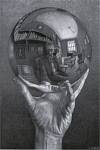
This photographer used his latest digital effects along with influence from M.C. Escher, my new favorite artist. Very interesting. Fits right into the Surrealists style.

This drawing from Escher teased my brain. One hand drawing another? Just another great work from the surrealism movement.

I really like this work, again by Escher. It amazes me that he had the ability to replicate reflections that seem extremely real. It almost feels like I was looking into the sphere. Except that I don't look like that and my room doesn't resemble the one in the reflection. Still it is a thinker!

Just thought that this was interesting. Primary colors really stand out in contrast to each other.
Given that we just created our own collages, I thought that I would add images of hobbies of mine in the form of collages.

I like playing
baseball. What I like about this collage is that it uses things that you would find in a ballpark as a theme. The peanuts used as leather threads was a good idea. I also like how the artist showed the fingers gripping the baseball.

Basketball!! My favorite sport of all. Speed, agility, quick thinking and reacting and pure athleticism. I just see a lot of random things in this collage. Nothing that really has to do with basketball. Perhaps the artist used these objects symbolically. I
just like the sport.

Fishing is amazingly relaxing. There's nothing like the sound of running water and birds
chirping and the feel of a fish striking your line. Again, the artist uses fishing objects as a theme. Different types of lures and baits are present along with nets and even a vest.

Like fishing, hunting is equally relaxing and has a great
excitement associated with it. Quiet mornings and nature's sounds then, a loud boom and the adrenaline is pumping. Same theme, hunting objects. Shotgun, shells, animals, knives and a bow.

Football is a sport that I enjoy but don't get to play often. I do watch my Cowboys every Sunday during football season though. Same theme here. You see the helmet, the football chin strap, the goal post face mask and the shoulder pad logo.




I'm not sure that I believe that crop circles are made by
UFO's or some really talented artist who likes working outside with crops instead of a canvas. But, artistically speaking, they have great balance and have clearly defined shapes and lines. Very intriguing.

Sometimes nature makes some pretty remarkable pieces of artwork. Looks like a human face to me. Or maybe the face of a lion or baboon! What do you see?

I thought that this was interesting. I noticed the shapes of the human body; legs, head, chest, and facial features. Then as I looked more I also saw that it could be seen as hills with trees and waterfalls. Really quite unique.

On our visit to the Art Gallery my wife and I were looking for one of her paintings and we came upon this one. Its a work by Sir Peter Paul Rubens. The theme of history and story was
obvious after reading out text. It's a story that I was told many times when I was young. It is interesting to see it from this light.

What do you see when you look at this? Most see the word MIRROR. It is
definitely there. What is so great about it? It is also a reflection of itself, perfect symmetrical balance. Draw a line down the middle of the dot in the middle and it is a perfect reflection.

I really thought that this was interesting. It is a work by M.C. Escher. If you look at it, it seems that the picture
displays two different scenes. If you look from the top towards the bottom, it looks as if the stairs are going down. If you look from the bottom up, the stairs seem to be going upwards and be underneath an archway. It is neat to see the way he uses value and
chiaroscuro to create this double image.


Chapter 5 discusses two main types of balance: symmetrical and asymmetrical. Symmetrical balance has an implied center of gravity that is the vertical axis where forms on either side of the axis correspond to one another in size, shape, and placement (125). Asymmetrical balance is similar though both sides don't match. The piece on the left is an example of symmetrical balance. Notice the image seems like an exact reflection across an imaginary axis. The piece on the right is an example of asymmetrical balance. Like the first, it seems like a reflection; however, the two sides are not matches. One has a larger tree and a larger mountain.

I like the atmospheric perspective used in these types of paintings. That's where the landscape seems to become hazy as it goes off into the distance. "Pictures are worth a thousand words" as the phrase goes. This painting sums up who I am. I enjoy everything outdoors. If I had to pick one word to describe how what I feel when I look at this... it would be envy.
























